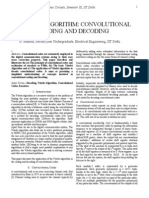VHDL Implementation of A Crossbar Packet Switch
VHDL Implementation of A Crossbar Packet Switch
Uploaded by
Vikas TarvechaCopyright:
Available Formats
VHDL Implementation of A Crossbar Packet Switch
VHDL Implementation of A Crossbar Packet Switch
Uploaded by
Vikas TarvechaOriginal Description:
Original Title
Copyright
Available Formats
Share this document
Did you find this document useful?
Is this content inappropriate?
Copyright:
Available Formats
VHDL Implementation of A Crossbar Packet Switch
VHDL Implementation of A Crossbar Packet Switch
Uploaded by
Vikas TarvechaCopyright:
Available Formats
VHDL Implementation of a Crossbar Packet Switch
Maryam Keyvani and Ljiljana Trajkovic {mkeyvani, ljilja}@cs.sfu.ca http://www.ensc.sfu.ca/research/cnl Communication Networks Laboratory, School of Engineering Science, Simon Fraser University
server_2
client_2
station_1
switch_3 station_2 switch_1 server_1 station_3 client_1 switch_2
Crossbar switch: Pros: non blocking Cons: complex control system Input buffers: input N-1 Pros: the fabric may have the input N same speed as the links Cons: head of line blocking (HOL) output 1 output 2 output N
input 1
An ATM switch is a network element that forwards ATM packets to their destinations.
Input buffered crossbar switch
Our switch consists of input ports, a centralized scheduler, output ports, and a switch fabric.
output data request grant output port ID
input data frame pulse Port1 port grant
output data frame pulse out data valid port request fabric
data out port1 data out fp out port1 data valid port1 incoming port to output1 output1 frame pulse out data and control signals 1 to 8 DEMUX
to output port1 2 3 4 5 6 7 8
Controller Main FIFO 2 KBytes VCI FIFO 128 Bytes Port LUT input data Input port
c_bar request scheduler
grant grant 64
Crossbar fabric DEMUX for the packet switch
2,4
2,4
3,3
3,3 3,4
3,4
1,1
1,2
1,3
1,4
4,2 4,3 4,4
4,2
4,3
4,4
1,1
2,1 2,2 2,3 2,4
1,2
1,3
1,4
1,1 1,2 1,3 1,4
1,1
1,2
1,3
1,4
2,1
3,1 3,2 3,3 3,4
2,2
2,3
2,4
2,1 2,2 2,3
2,1
2,2
2,3
2,4
3,1
3,2
3,3
3,4
3,1 3,2
3,1
3,2
3,3
3,4
4,1
4,1 4,2 4,3 4,4
4,2
4,3
4,4
4,1
4,1
4,2
4,3
4,4
1,1
1,2
1,3
Simple 4x4 arbiter
Logic inside an arbiter cell
A cyclic two-dimensional ripple carry arbiter
Rectilinear Propagation Arbiter (RPA) architecture
Modified arbitration cell for RPA architecture
Diagonal Propagation Arbiter (DPA) architecture
2,1
2,2
3,1
Shaded cells are cells with grants Disadvantage: fixed priority for 1,1 arbiter
A grant signal is only issued when there are no grants issued for cells on the top and left
Shaded cells are cells with grants, assuming (2,3) is the highest priority cell Disadvantage: combinational feedback loop
Highest priority cell = (1,1)
Reference: J. Hurt, A. May, X. Zhu, and B. Lin, Design and implementation of high-speed symmetric crossbar scheduler, Proc. ICC99, Vancouver, Canada, June 1999, s37-6.
Shaded cells are cells that DPA architecture with have received grants priority rotation Disadvantage: first diagonal always has the Shaded cells are cells with highest priority grants, when the highest priority is the first diagonal
ASI Exchange March 13, 2001
You might also like
- QATAR TRTO OPERATIONS AND TRAINING MANUAL (Rev 08) PDFDocument169 pagesQATAR TRTO OPERATIONS AND TRAINING MANUAL (Rev 08) PDFcristi moater67% (3)
- Safety Procedures in ConstructionDocument21 pagesSafety Procedures in ConstructionMalith De Silva100% (1)
- Wire-And Strand-Wound, Circular, Prestressed Concrete Water TanksDocument110 pagesWire-And Strand-Wound, Circular, Prestressed Concrete Water TanksMourad MoulaniNo ratings yet
- Solar Inverter Charger Communication Protocol PDFDocument8 pagesSolar Inverter Charger Communication Protocol PDFPatrick JamesNo ratings yet
- NX700 - Communication Interface - 03EDocument80 pagesNX700 - Communication Interface - 03ESowji PNo ratings yet
- SAP ABAP Interview QuestionsDocument8 pagesSAP ABAP Interview QuestionsPrashanth Reddy50% (2)
- Bell System ManualDocument34 pagesBell System Manualgoldie146No ratings yet
- At Pop RecordDocument84 pagesAt Pop Recordedward77100% (3)
- TSB 2000010 Technical Overview of The STERILIZABLEBAGDocument4 pagesTSB 2000010 Technical Overview of The STERILIZABLEBAGdatinjacabNo ratings yet
- KLM E1sDocument4 pagesKLM E1sMinto Issac100% (1)
- CS610 SubjectiveDocument28 pagesCS610 Subjectivesabiha kamranNo ratings yet
- How To Use Data LoggerDocument91 pagesHow To Use Data LoggerFaizan NazirNo ratings yet
- CS601 Solved MCQs Compiled Mid-Giga-File With 300-PagesDocument479 pagesCS601 Solved MCQs Compiled Mid-Giga-File With 300-PagesKainat IjazNo ratings yet
- Kalasalingam Academy of Research and Education Office of The Controller of ExaminationsDocument40 pagesKalasalingam Academy of Research and Education Office of The Controller of ExaminationsBuvanesh Buvi VnrNo ratings yet
- Viterbi DecoderDocument7 pagesViterbi Decodermuthuraj14007No ratings yet
- Solved Paper of CS601-Data Communication Uploaded by Zaid KhanDocument13 pagesSolved Paper of CS601-Data Communication Uploaded by Zaid KhanSaleempakistani100% (1)
- Guia - Interfaceamento - LABMAX240Document60 pagesGuia - Interfaceamento - LABMAX240Leandro DoninNo ratings yet
- Seaking Remote Comms Ops ManDocument27 pagesSeaking Remote Comms Ops MancoiNo ratings yet
- Research of Serial Communication Based On STM32: Jian HuangDocument3 pagesResearch of Serial Communication Based On STM32: Jian HuangHenil GajjarNo ratings yet
- What Is The Difference Between The Physical and Logical Topologies?Document6 pagesWhat Is The Difference Between The Physical and Logical Topologies?usmandilshadmNo ratings yet
- 11timing Concepts and Physical DesignDocument42 pages11timing Concepts and Physical DesignTeja Reddy100% (3)
- Spreading Codes in Cdma Detection: Eastern Mediterranean University July 2003Document24 pagesSpreading Codes in Cdma Detection: Eastern Mediterranean University July 2003Alex BadeaNo ratings yet
- EEE248 CNG232 Lab Manual Spring2013Document40 pagesEEE248 CNG232 Lab Manual Spring2013Ibrahim AladoğanNo ratings yet
- Data EncrytipnDocument5 pagesData EncrytipnRajan MiglaniNo ratings yet
- Design and Verification of Daisy Chain Serial Peripheral Interface Using System Verilog and Universal Verification MethodologyDocument10 pagesDesign and Verification of Daisy Chain Serial Peripheral Interface Using System Verilog and Universal Verification MethodologyTELKOMNIKANo ratings yet
- TMD-T4: Communication Protocol Instruction ManualDocument12 pagesTMD-T4: Communication Protocol Instruction Manualruben linaresNo ratings yet
- 4staur S7 Ethernet To Mpi AdapterDocument35 pages4staur S7 Ethernet To Mpi Adaptervoltus88No ratings yet
- (90-50-3000-SC1) 50i - Bi-Directional Communication - V1.06Document50 pages(90-50-3000-SC1) 50i - Bi-Directional Communication - V1.06MatrixNo ratings yet
- The New Packet Scheduling Algorithms For VOQ Switches: (Anna - Baranowska, Wojciech - Kabacinski) @et - Put.poznan - PLDocument6 pagesThe New Packet Scheduling Algorithms For VOQ Switches: (Anna - Baranowska, Wojciech - Kabacinski) @et - Put.poznan - PLmfhfhfNo ratings yet
- GMK 5100 ECOS Error Codes V2Document9 pagesGMK 5100 ECOS Error Codes V24g lite100% (1)
- Cisco 892 Performance TestDocument39 pagesCisco 892 Performance TestYibrail Veliz PluaNo ratings yet
- NT00337-EN-01 - Flair 23DM Modbus Protocol PDFDocument32 pagesNT00337-EN-01 - Flair 23DM Modbus Protocol PDFHung Cuong PhamNo ratings yet
- A Survey On Designing of Turbo Encoder & Turbo DecoderDocument8 pagesA Survey On Designing of Turbo Encoder & Turbo DecoderIJAFRCNo ratings yet
- Networks Part1Document9 pagesNetworks Part1arjunNo ratings yet
- nternational Journal of Computational Engineering Research(IJCER) is an intentional online Journal in English monthly publishing journal. This Journal publish original research work that contributes significantly to further the scientific knowledge in engineering and Technology.Document6 pagesnternational Journal of Computational Engineering Research(IJCER) is an intentional online Journal in English monthly publishing journal. This Journal publish original research work that contributes significantly to further the scientific knowledge in engineering and Technology.International Journal of computational Engineering research (IJCER)No ratings yet
- Pages From Cisco - 400-101Document170 pagesPages From Cisco - 400-101sunny.choudaryNo ratings yet
- Keykeriki v2 Cansec v1.1Document63 pagesKeykeriki v2 Cansec v1.1WALDEKNo ratings yet
- A Quick Guide To Reversible Logic 6-1Document20 pagesA Quick Guide To Reversible Logic 6-1Mochamad NursidiqNo ratings yet
- Troubleshoot Punt Fabric Data Path FailuDocument60 pagesTroubleshoot Punt Fabric Data Path FailuSameer GulshanNo ratings yet
- The Design of RFID Tag For "Mywallet"Document4 pagesThe Design of RFID Tag For "Mywallet"SEP-PublisherNo ratings yet
- UsartDocument15 pagesUsartsy2024286No ratings yet
- Star 800 Mib Hardware ConfigurationDocument19 pagesStar 800 Mib Hardware ConfigurationthendisnerNo ratings yet
- Communication Interface: EM70 Servo ControllerDocument16 pagesCommunication Interface: EM70 Servo ControllerChristianNo ratings yet
- Cadence - Virtuoso: Amity UniversityDocument27 pagesCadence - Virtuoso: Amity UniversityAkhil Aggarwal100% (1)
- EVPN On Demand Next Hop Design With Implementation of Segment Routing Traffic Engineering - LTRSPG-2431Document42 pagesEVPN On Demand Next Hop Design With Implementation of Segment Routing Traffic Engineering - LTRSPG-2431pavanNo ratings yet
- Module 1 Ethernet and VLANDocument10 pagesModule 1 Ethernet and VLANAlex MachadoNo ratings yet
- A. Network Layer (Intro + VCs and Datagrams)Document14 pagesA. Network Layer (Intro + VCs and Datagrams)Qamar AbbasNo ratings yet
- mnl100 Interface ManualDocument40 pagesmnl100 Interface ManualDavid WalkerNo ratings yet
- Lab 7Document6 pagesLab 7Minh NamNo ratings yet
- Ijert Ijert: Implementation of Interleaving Switch Based Architecture For System On ChipDocument7 pagesIjert Ijert: Implementation of Interleaving Switch Based Architecture For System On ChipAkhila ReddyNo ratings yet
- Data Communications and Networking 2 All SourceDocument81 pagesData Communications and Networking 2 All Sourceranelquinto12No ratings yet
- LDPCDocument30 pagesLDPCsrinivas_chp100% (1)
- 02-C Ethernet RMON Performance ListDocument4 pages02-C Ethernet RMON Performance ListShakeb AmirNo ratings yet
- VSCA Serial Communications BoardDocument10 pagesVSCA Serial Communications BoardRedaMedNo ratings yet
- Spring 2010 CS610-Computer Network Time: 60 Min Marks: 40 Student ID: Moona Center: Exam DateDocument11 pagesSpring 2010 CS610-Computer Network Time: 60 Min Marks: 40 Student ID: Moona Center: Exam Datehassan_m2222No ratings yet
- Forward Discrete Wavelet Transform IP User GuideDocument8 pagesForward Discrete Wavelet Transform IP User GuideDao Thanh MaiNo ratings yet
- Gargi Sharma Viterbi Algorithm Term Paper EEL201Document4 pagesGargi Sharma Viterbi Algorithm Term Paper EEL201Gaurav NavalNo ratings yet
- Plagiarism Checker X Originality: Similarity Found: 22%Document9 pagesPlagiarism Checker X Originality: Similarity Found: 22%alisha DhawanNo ratings yet
- Nmea FaqDocument7 pagesNmea FaqFerdy Fer DNo ratings yet
- Design and Implementation of UART Based On VerilogDocument7 pagesDesign and Implementation of UART Based On VeriloglabibatariqueNo ratings yet
- ProjectDocument22 pagesProjectsneha75501No ratings yet
- Tms 320 F 28035Document157 pagesTms 320 F 28035Madalina-Alexandra PuscasuNo ratings yet
- Labmanual 1 and 2Document22 pagesLabmanual 1 and 2Mudassar AliNo ratings yet
- RTTC Pune Presents..: An-RaxDocument31 pagesRTTC Pune Presents..: An-RaxShishir NaikNo ratings yet
- Token Bus Message Exchange in Token Bus: "Token"-Procedure: Only Someone Who Possesses A Certain Token ( Bit Sequence)Document5 pagesToken Bus Message Exchange in Token Bus: "Token"-Procedure: Only Someone Who Possesses A Certain Token ( Bit Sequence)nenada2No ratings yet
- Connection-Oriented Networks: SONET/SDH, ATM, MPLS and Optical NetworksFrom EverandConnection-Oriented Networks: SONET/SDH, ATM, MPLS and Optical NetworksNo ratings yet
- Digital Signal Processing Techniques and Applications in Radar Image ProcessingFrom EverandDigital Signal Processing Techniques and Applications in Radar Image ProcessingNo ratings yet
- Datasheet Sandvik 12c27 enDocument4 pagesDatasheet Sandvik 12c27 enRizqi D. KurniantoNo ratings yet
- The CAMPUS Polymer DatabaseDocument10 pagesThe CAMPUS Polymer DatabaseFERNANDO JOSE NOVAESNo ratings yet
- Awa Msdv2413-03-d0 User ManualDocument62 pagesAwa Msdv2413-03-d0 User ManualpaiuiaNo ratings yet
- Installers Guide Bs 8418Document2 pagesInstallers Guide Bs 8418mmhaq1975No ratings yet
- MSC 1-Circ 1368 PDFDocument8 pagesMSC 1-Circ 1368 PDFKowalski Krzysztof100% (1)
- CAPASITORDocument89 pagesCAPASITORAn DrewNo ratings yet
- Bank LoanDocument441 pagesBank LoanDhansiri HouseNo ratings yet
- Electric Heating Control PanelsDocument7 pagesElectric Heating Control PanelsAmet koko TaroNo ratings yet
- Building MaterialsDocument10 pagesBuilding MaterialssivagamipalaniNo ratings yet
- 01.54.455475 IM8 & IM9 Series Patient Monitor User Manual-1.0Document256 pages01.54.455475 IM8 & IM9 Series Patient Monitor User Manual-1.0Anonymous HkWQZrLNo ratings yet
- SI-01 - R03 Banksman-Crane Operations PDFDocument64 pagesSI-01 - R03 Banksman-Crane Operations PDFFatih D. PrasetioNo ratings yet
- Audi A4, A5, Q5 (B8) ABS MVB - Measuring Value BlocksDocument10 pagesAudi A4, A5, Q5 (B8) ABS MVB - Measuring Value BlocksKeldo GlianaNo ratings yet
- Construction Quality ControlDocument3 pagesConstruction Quality ControlJo MNo ratings yet
- Haydon Idea pcm4806 pcm4826 Drive Data 106Document3 pagesHaydon Idea pcm4806 pcm4826 Drive Data 106TOPOTRONIKNo ratings yet
- Ipv6 Cheat SheetDocument2 pagesIpv6 Cheat SheetKarlNo ratings yet
- AV485Document4 pagesAV485AF VMNo ratings yet
- Organisational Resilience The Relationship With Risk Related Corporate StrategiesDocument28 pagesOrganisational Resilience The Relationship With Risk Related Corporate StrategiesdeepakNo ratings yet
- Performing The UpgradeDocument23 pagesPerforming The Upgrademaricon18No ratings yet
- Man HoursDocument15 pagesMan Hoursjanpaul24810% (1)
- Jawwal PDFDocument13 pagesJawwal PDFDereje FelekeNo ratings yet
- Fly Ash: Boral CementDocument1 pageFly Ash: Boral CementBhuidhar VermaNo ratings yet
- Building A Secure Local Area NetworkDocument71 pagesBuilding A Secure Local Area Networkhosny1234No ratings yet
- Service Bulletin: Piper Considers Compliance MandatoryDocument5 pagesService Bulletin: Piper Considers Compliance MandatoryCarlos MNo ratings yet

























































































